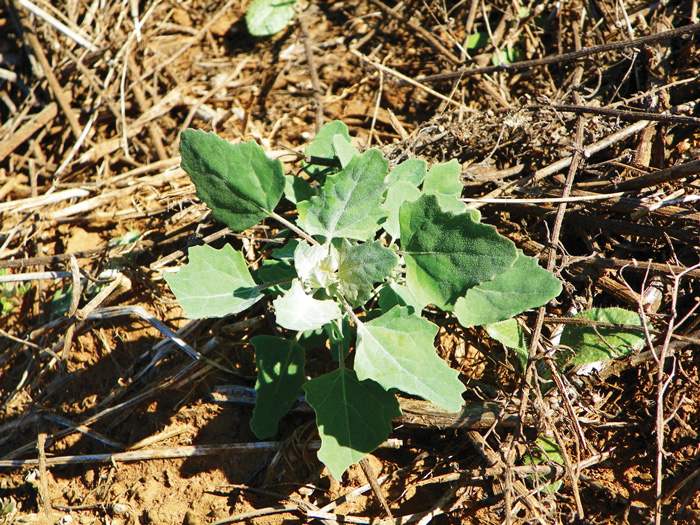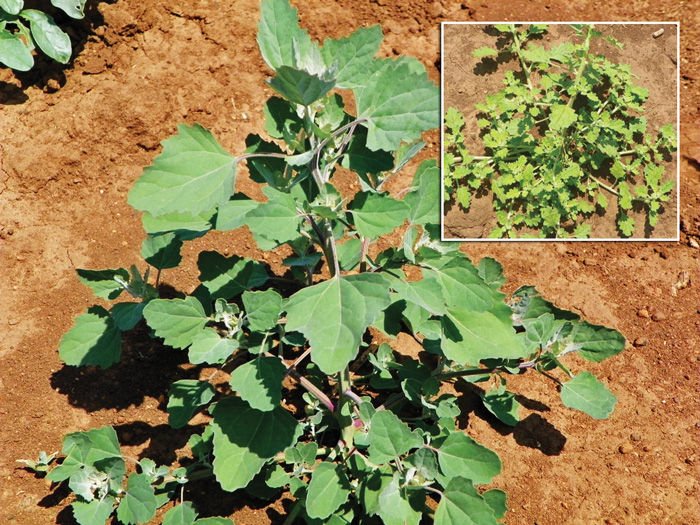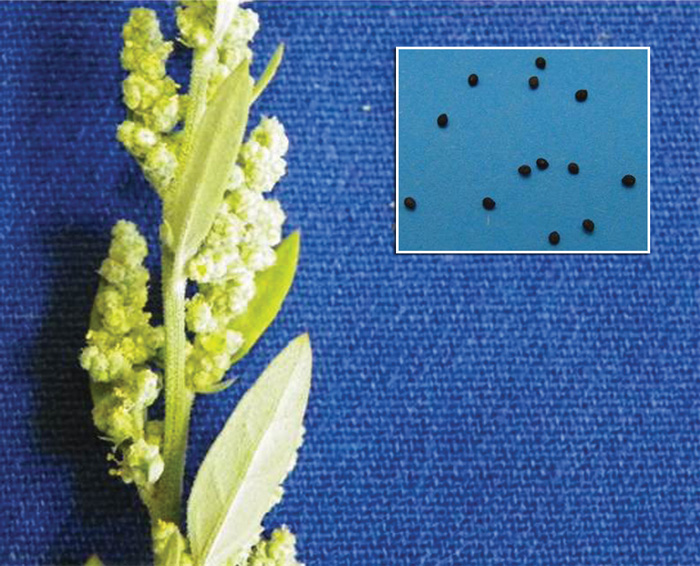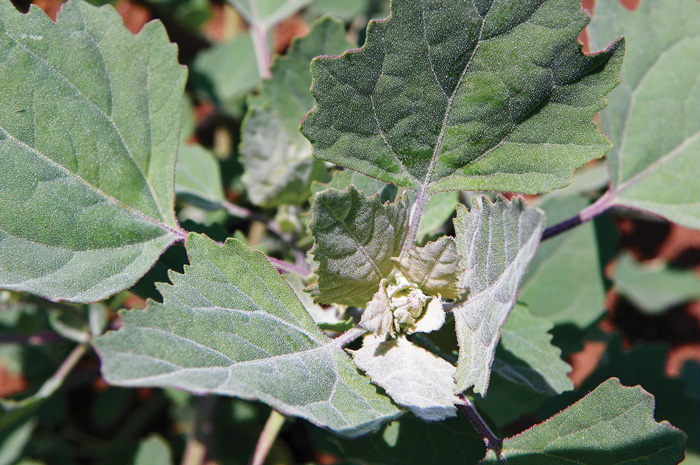Category: WEED SERIES
 |
 |
 |
Young white goosefoot. |
Mature white goosefoot and green goosefoot (insert). |
 |
Flower axillaries with shine black seed (insert). |
 |
Soft white hairy appearance of leaves and red-purple colour of stems. |
Scientific name: Chenopodium album
Afrikaans name: Withondebossie, bloubossie, hondepisbossie, seepbossie of varkbossie
English name: White goosefoot, fat hen, wild spinach
White goosefoot is an annual, multi-branched, erect herb that can grow as tall as 1,5 m. This weed has a sturdy taproot and the stems are ribbed, green-yellowish, often reddish striped and hairless.
The leaves are simple, alternately arranged and vary from lancet-shaped to egg-shaped. The leaf margins can be entire or irregularly toothed and are dark green at the top and floury white below.
Seedlings can appear woolly due to the white colouring of the young leaves. Leaves can be 5 cm long and 3 cm wide. The flowers of Chenopodium are green in thick self-standing axillary plumes, with no crown and five keeled calyx leaves. The seeds are lenticular, black and shiny and up to 1,5 mm in diameter.
This weed is commonly referred to as ‘morog’ or pigweed, but this weed must not be confused with Amaranthus species which are also edible. Chenopodium is widespread in South Africa, is frost tolerant and occurs regularly in winter crops.
Cultivation
Chenopodium can be controlled through shallow cultivation at the seedling stage.
Chemically
The most effective way to control this weed is by using herbicides. Several herbicides are registered for use on this weed in maize and wheat (Table 1 and Table 2). Follow the instructions and dosage recommendations on the label carefully. Be aware that green goosefoot is also a Chenopodium spp. (C. carinatum) and while most of the herbicides listed in Table 1 and Table 2 will also control green goosefoot, it is still necessary to make sure which Chenopodium spp. is indicated on the herbicide label. Always contact a reliable chemical advisor before using any chemicals to ensure the correct doses and specifications on the label are adhered to. All herbicides registered for the control of weeds are summarised in the publication A guide to the chemical control of weeds in South Africa. A CropLife South Africa Compendium.
TABLE 1: Broadleaf herbicides registered on maize to control white goosefoot.
| Active ingredient | Formula | Time of application |
|---|---|---|
|
2,4-D |
480 g/litre |
Post-emergence when crop is 30 cm tall or apply as directed spray |
|
2,4-D/dicamba |
240/80 g/litre |
Post-emergence on actively growing weeds, five to six leaf stages |
|
acetochlor/atrazine/simazine |
160/165/165 g/litre |
Pre-emergence at, or just after planting |
|
acetochlor/atrazine/terbuthylazine |
125/187,5/87,5 g/litre 150/225/225 g/litre 178,6/160,7/160,7 g/litre 200/150/150 g/litre 250/225/225 g/litre 350/175/175 g/litre |
Pre-emergence at planting, or within three days after planting Early post-emergence, not later than fourth leaf stage of weed |
|
alachlor/atrazine |
336/144 g/litre |
Pre-emergence at planting or within two days after planting. Some products should not be applied on sandy soils with a clay content of less than 16% |
|
atrazine |
500 g/litre 900 g/kg |
Pre-emergence on well prepared seedbed |
|
atrazine/cyanazine |
167/333 g/litre 250/250 g/litre |
Pre-emergence or early post-emergence |
|
atrazine/mesotrione/s-metolachlor |
208,5/26,8/208,5 g/litre |
Pre-emergence application |
|
atrazine/metazachlor/terbuthylazine |
210/60/210 g/litre |
Pre-emergence within three days after planting. Can be followed-up with an early post-emergence application |
|
atrazine/metolachlor |
300/300 g/litre |
Pre-emergence within three days after planting |
|
atrazine/metolachlor/terbuthylazine |
174/252/174 g/litre 262,5/175/262,5 g/litre |
Pre-emergence or early post-emergence before the fourth leaf stage of weed |
|
atrazine/s-metolachlor |
370/290 g/litre |
Pre-emergence just after planting |
|
atrazine/s-metolachlor/terbuthylazine |
248,6/102,8/248,6 g/litre |
Pre-emergence |
|
atrazine/sulcotrione |
300/125 g/litre |
Pre- or post-emergence |
|
atrazine/terbuthylazine |
250/250 g/litre 270/270 g/litre 300/300 g/litre 450/450 g/kg |
Pre-emergence or post-emergence before fourth leaf stage of weed |
|
atrazine/terbutryn |
250/250 g/litre |
Pre-emergence at planting or just after planting |
|
bendioxide |
480 g/litre |
Post-emergence |
|
bromoxynil |
225 g/litre 400 g/litre 450 g/litre 500 g/litre |
Post-emergence of weed between four and six leaf stage |
|
bromoxynil/terbuthylazine |
150/333 g/litre |
Post-emergence |
|
dicamba |
480 g/litre 700 g/kg |
Post-emergence when crop is 30 cm tall |
|
dicamba/topramezone |
160/50 g/litre |
Early post-emergence before six leaf stage of weed. Apply in tank mix with atrazine or atrazine/terbuthylazine |
|
EPTC |
720 g/litre |
Pre-plant incorporated into the soil. See product label for application specifications |
|
MCPA |
700 g/kg 400 g/litre |
Pre-emergence within five to six days after planting Post-emergence up until crop is 30 cm tall |
|
mesotrione |
480 g/litre |
Pre- or post-emergence. Apply in tank mix with atrazine, atrazine/terbuthylazine or s-metolachlor |
|
mesotrione/s-metolachlor |
83,3/416,7 g/litre |
Pre-emergence |
|
s-metolachlor/terbuthylazine |
102,8/497,2 g/litre |
Pre-emergence |
|
metribuzine |
480 g/litre |
Post-emergence between four and six leaf stage of weed in tank mix with 2,4-D or bromoxynil |
|
terbuthylazine |
500 g/litre |
Post-emergence of weed in tank mix with 2,4-D/dicamba |
|
topramezone |
336 g/litre |
Early post-emergence before six leaf stage of weed. Apply in tank mix with atrazine or atrazine/terbuthylazine |
Note: Some grass herbicides such as acetochlor, s-metolachlor, alachlor and s-dimethenamid can be applied pre-emergence in maize to control white goosefoot. Glyphosate can be applied post-emergence where
glyphosate-resistant maize cultivars have been planted.
TABLE 2: Broadleaf herbicides registered on wheat to control white goosefoot.
| Active ingredient | Formulation | Time of application |
|---|---|---|
|
2,4-D |
480 g/litre 500 g/litre |
Post-emergence when crop is between growth stage seven and 13. Apply only in summer rainfall regions (not in KwaZulu-Natal) |
|
bendioxide |
480 g/litre |
Post-emergence on actively growing weed seedlings |
|
bromoxynil |
225 g/litre 400 g/litre 450 g/litre 500 g/litre |
Post-emergence where weeds are fully germinated and not older than six leaf stage Post-emergence when wheat is between the third and end of stooling growth stage Post-emergence where weeds are fully germinated and not older than six leaf stage Wheat should be between third leaf and booting growth stage |
|
bromoxynil/pyrasulfotole |
210/37,5 g/litre |
Post-emergence in winter rainfall region when weed is between four and six leaf stage |
|
carfentrazone-ethyl/ metsulfuron-methyl |
400/100 g/kg |
Post-emergence in the Western, Southern and Eastern Cape Provinces when wheat is between three to five leaf growth stages |
|
chlorsulfuron |
750 g/kg |
Post-emergence when wheat is between two to five leaf growth stage |
|
chlorsulfuron/metsulfuron- methyl/tribenuron-methyl |
119/79/222 g/kg |
Post-emergence in the Western, Southern and Eastern Cape Provinces when wheat is between four to six leaf growth stages |
|
dicamba |
700 g/kg |
Post-emergence only in tank mix with Enhancer (10 g - 12 g) + Reaper (10 g) + adjuvant |
|
diflufenican |
500 g/litre |
Post-emergence only in winter rainfall region when wheat has been established. Read product label for specifications on application |
|
florasulam/flumetsulam |
75/100 g/litre |
Post-emergence only in winter rainfall regions. Apply when wheat is between second leaf stage and before end of tilling. Weeds should be in seedling stage |
|
iodosulfuron-methylsodium/ mefenpyr-diethyl |
50/150 g/kg |
Post-emergence only in winter rainfall regions, before fourth leaf stage of weed or 3 cm tall |
|
iodosulfuron- methylsodium/metsulfuron- methyl/mefenpyr-diethyl |
30/30/90 g/kg |
Post-emergence only in winter rainfall regions, before the fourth leaf stage of weeds or 3 cm tall |
|
MCPA |
400 g/litre 700 g/kg |
Post-emergence when wheat is between seven to 13 growth stage Mainly annual broadleaf weeds in dry land wheat |
|
metsulfuron-methyl/ thifensulfuron-methyl |
68/680 g/kg |
Post-emergence when weed is between fourth to fifth leaf stage |
|
metsulfuron methyl/ tribenuron methyl |
80/300 g/kg 120/600 g/kg 200 g/kg |
Post-emergence in the Western and Southern Cape Provinces when wheat is between four to six leaf stage. Apply only in tank mix with 2,4-D ester or Voloxynil B 225 EC |
|
metsulfuron-methyl |
500 g/kg 600 g/kg |
Post-emergence only in winter rainfall regions when wheat is between three and five leaf stage |
|
prosulfuron |
750 g/kg |
Post-emergence when weed is between four and five leaf stage |
|
pyraflufen-ethyl |
20 g/litre |
Post-emergence only in winter rainfall regions when weeds are between two to four leaf stage. Apply in tank mix with MCPA and bromoxynil |
|
thifensulfuron-methyl |
750 g/kg |
Post-emergence in Western, Southern, Eastern Cape Provinces in tank mix with Enhancer and adjuvant. Wheat should be between two and five leaf stage and not later than four weeks after weed emergence |
|
triasulfuron |
750 g/kg |
Apply at planting in the Western and Eastern Cape Province regions |
|
tribenuron-methyl |
750 g/kg |
Post-emergence only in winter rainfall regions and irrigated wheat in summer rainfall regions when wheat is between three and fifth leaf stage |
|
trifluralin |
480 g/litre |
Only use in planted fields. Read label |
Contact the writers at elbe.hugo@syngenta.com (Elbe Hugo) and, deweth@arc.agric.za (Hestia Nienaber).